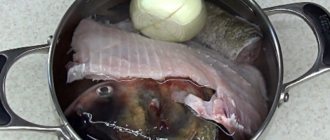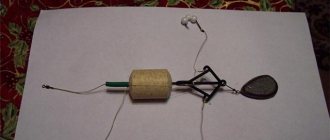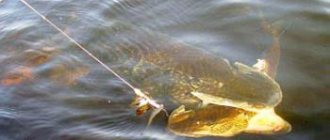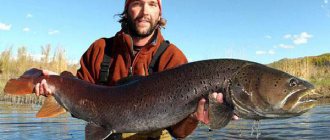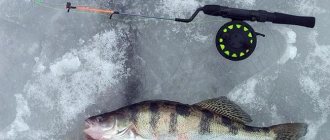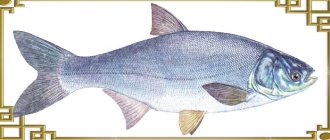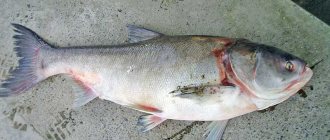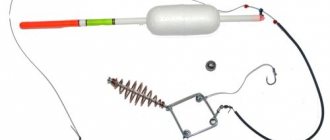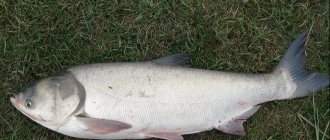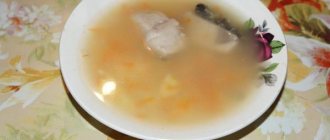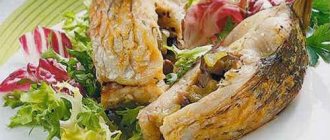Features of catching silver carp in winter
Silver carp or silver carp fish belongs, of course, to heat-loving relatives from the carp family. This is especially noticeable in the increased bite of silver carp only in very warm water, which is also typical for carp. Obviously, due to many similar traits and characteristics inherent in the cultivated carp, silver carp is also called “silver carp.”
Silver carp are also highly thermophilic during the spawning period, which is possible for these fish only when the water temperature reaches plus 18-20 degrees, if you use the Celsius scale. Another very characteristic feature of silver carp is their ability to purify blooming water, turning it from muddy and green to completely transparent and clean. Crafty silver carp have learned to strain and filter out flowering greens, simply feeding on this plant “plankton”. This makes this fish similar to grass carp, which is also a cleaner of reservoirs, but from larger vegetation.
Since winter fishing is impossible in Asian rivers, so to speak, by default, this fish is caught in the rivers and bays of the Amur basin in winter. Silver carp have also taken root in the basins of the Kuban River and in the estuaries of the Aral Sea. However, now in many other reservoirs, silver carp have become an ordinary fish, desired as a trophy, tasty and even medicinal and dietary in its nutritional and gastronomic qualities. Moreover, this is probably the only freshwater fish with a high fat content, like fish that inhabit the seas. And what is surprising is that when eating silver carp meat, patients and those on a diet lower their cholesterol levels, despite the high content of fish oil in this fish.
Wherever silver carp have assimilated, it catches best in winter in reservoirs with relatively warm water, even under ice. But this does not happen everywhere. In some reservoirs, ice springs gush from the bottom, and the water in such places is on the verge of freezing due to the temperature regime. On the contrary, ponds and reservoirs at nuclear power plants, the water of which is used to cool the nuclear reactor and then returns back, warmer than when it was taken into the coolers of the nuclear power plant, are the most preferable for breeding silver carp. Moreover, during the flowering period, which usually occurs in July-August, silver carp will keep the water in the pond clean and clear. But in such reservoirs, winter fishing is usually done with summer gear, which includes a feeder and a float rod. Only in the bays on the opposite side of the cooling pond are silver carp caught from the ice.
The most common winter fishing for silver carp is in the so-called “platniki”, where winter fishing rods catch specimens weighing up to 5-8 kg. However, this will not surprise experienced summer fishermen who catch silver carp in the eriks and bays of the Kuban, as well as in the estuaries of the Aral Sea, where specimens weighing up to 50 kg are not uncommon.
In their habitats, silver carp choose places with a muddy bottom and dense vegetation, where they find plant food and various larvae to replenish protein. The bighead carp is more prone to animal food. Its close relative, the silver carp, prefers more plant foods, which plays an important role when choosing bait for fishing.
The choice of gear for catching silver carp from ice is small. Most often, a classic winter fishing rod is used, but with much stronger equipment than for catching ordinary winter roach, bream and even bream. After all, very large fish can bite, and silver carp are strong on the hook, like carp and carp. A float fishing rod with equipment that uses a pop-up float is also used. Sometimes the most successful rig is a bottom with a tackle made from a combination of cylinders of technoplankton or makukha, as bait, and hooks with mounted foam or the same technoplankton, makukha or corn grains.
Spinning silver carp is not practiced. If he gets caught on a lure, it’s most likely purple. There is, however, a more modern method, which is also used in paid ponds for trout fishing. And we'll talk about this in the next chapter.
Catching silver carp with edible rubber baits
On some paid ponds, where, due to the successful breeding of silver carp, the fish have reached a large size, large individuals are not averse to grabbing something more serious than bloodworms or a grain of corn on a hook. Many large fish at high densities begin to seriously compete for food. And they even begin to show some predatory habits, as happens with seemingly peaceful fish: roach and bream.
Not long ago, very strange creatures appeared on the fishing lure market in the form of representatives from horror films like “Alien” and other blockbusters.
Only these “alien” ones are small in size and made of so-called edible rubber. These baits are similar to characters from horror films in the presence of various active tentacles, tails, claws and other details of imaginary crustaceans or insects. Such baits are called Hogy Hog and are intended more for catching perch and other predators, but they are also successfully used when catching large trout on fishing grounds. What is the reason for the success of these fairly new lures? The fact is that they consist of more than half of material that has smell and taste. Moreover, the bait is also thickly coated with oil, about 30 percent. Although the oil is washed off during long-term intensive fishing, the taste and smell of the bait remains throughout the entire fishing trip.
Larger active predators use larger baits that are measured in inches. Their usual size is 1.6 inches. For trout and silver carp fishing, the 1.2-inch Hoggy Hog is most suitable.
Despite the fact that these original lures have a rich palette of colors, especially bright, aggressive ones, designed for catching active predators, for fishing for silver carp using Hogi Hogs made of edible rubber, the colors of the lures are required to be more natural, not very bright. The most suitable colors are green, brown, yellow and white.
As for the taste and smell of edible rubber baits, for cold water Hogi Hogs with the smell and taste of crayfish, crab, shrimp, fish, and fish roe are usually used. All these smells and tastes are also successfully used in bait for late autumn and winter when fishing for carp and carp, and silver carp is a direct relative of these fish. And he is not alien to the tastes and habits of his classmates.
Hogy Hog baits made of edible rubber are attached both to a hook, which is more suitable for catching silver carp, and to a small jig. But silver carp are not predators and active baiting is not required to catch them. Therefore, when catching this fish on the Hogi Hog, you can use a medium-sized jig measuring 2.5 mm in black, green, brown or another dull color. And for stand-up fishing, summer rigging is more convenient, where the hook is located under the sinker at a distance of 10-12 cm.
Since the silver carp on paid ponds are quite large, it would not hurt to wind a braided cord with a diameter of 0.2-0.25 mm on the reel of a winter fishing rod. A fluorocarbon leash of the same diameter or thinner is used if the fish in the pond at this time are cautious, sluggish and small. Hooks are used No. 4-5 of our numbering.
The baits of the well-known company Lucky John, which were discussed above, as universal, possessing smell and taste, can be effectively used in winter fishing for silver carp - silver carp.
A winter fishing rod with a large open reel and a soft nod is suitable as a fishing rod for winter fishing for silver carp. The gear may be similar to gear that is usually used for catching bream.
When choosing a place for winter fishing for silver carp, it is advisable to know the bottom topography and the summer habitat of this fish. Usually these are muddy areas of the reservoir with a depth of 3-3.5 meters. It’s good when in the middle of soft silt there are “patches” with a harder clay or sandy bottom. These will be the tables set for the silver carp's breakfast and lunch. You need to have several of these tables in stock, feeding them in advance or imparting them with long-term bait. Then you can hope for a good result in silver carp fishing.
Fishing for silver carp in winter with equipment with technoplankton
Just as in the summer, for catching silver carp, donks with equipment consisting of technoplankton feed cylinders purchased in fishing stores, with hooks suspended nearby on short leashes, are very successfully used. Both vegetable bait in the form of corn kernels, crumbs and bread crusts, and inedible polystyrene foam balls are attached to the hooks. Despite the fact that no one ever eats styrofoam, it sometimes attracts fish more than corn kernels due to its positive buoyancy, while corn simply lies on the bottom. Styrofoam balls floating next to the technoplankton container, mounted on hooks, are absorbed by silver carp faster and more reliably. The principle of fishing is the operation of bait, namely a container with technoplankton, which, when dissolved, creates a cloud of food turbidity attractive to fish, in which the silver carp simply retracts the hooks with the nozzle. This is very similar to one of the most original ways of catching bream using a “spring”. There, a not very thick and tough semolina porridge is pressed into a metal spring, in which there are one or two leashes with hooks. The bream, stretching out its lips with the famous tube, sucks the porridge from the spring, and along the way, the hooks. Only large bream are caught on such a strange rig.
Technoplankton containers have a composition that is actually implied in the name itself, that is, living plankton, dried, like fish food. However, a variety of underwater small insects, including the famous daphnia, which are used for aquarium fish, are also included in this pressed zooplankton, as well as phytoplankton. Both plant and animal plankton are included in the regular diet of even such large fish as silver carp. In addition to the nutrient base of plankton, various flavors are added to the composition of this bait and bait. For summer, as a rule, sweet scents are used: vanilla, anise, fruit and berry components. And for cold water, bloodworms, worms, maggots, fish and bone meal, syrups with the smell of cancer, mackerel, salmon, hemp in fish, and crab are added to the technoplankton. At least these components are added by clever fishermen when making homemade baits and containers with technoplankton.
As in fishing for edible rubber, bottom tackle is equipped with a braided cord with a diameter of 0.2-0.25 mm and hooks No. 4-5 of domestic numbering. It is better to use monofilament for leashes, otherwise, made of cord, they will desperately get tangled and tangled. A thread is just a thread...
For bottom fishing, regular-class fishing rods are used, designed for stand-up fishing, which are equipped with stands for installing the fishing rod next to the hole. The nod works like the most common guard - a bite alarm.
Fishing with bottom gear will be most successful if the fishing spot has been baited repeatedly over several days. And it’s best when there is no fishing in such places during the entire period when the fish are attached. And the shortest period for a successful bait is usually 4 days. But it is better if the attachment lasts a week. The bait principle creates the prerequisites for effective fishing with any gear used in silver carp fishing.
Methods of catching silver carp: tackle
The main rule for catching silver carp is to choose strong and durable gear. You shouldn't underestimate him. This powerful fish offers strong resistance when fishing. With one sharp movement it can tear a strong fishing line and break a strong tackle.
The diameter of the fishing line varies from 0.5 to 0.1 mm, the diameter of the leader is 0.35-0.4 mm, the hook size is 8.5-10. Choose a sharp and long sting. Since this fish is careful, the length of the leash should be 70-100 cm, but not shorter. The proximity of the sinker to the bait frightens the elusive fish.
There are several types of gear.
Donnaya
It differs from float tackle in the absence of a float.
Large specimens are caught with it. The bottom tackle must be made rough, since the fishing rod is not used. It is convenient to place it at a distance of 6 m from each other. This will avoid the gear getting tangled if the fishing is in the current. Bottom tackle is easy to use without any tricks. The main quality is power to cast heavy equipment and bring out strong fish. There is no difference in the choice between monofilament and cord. But the fishing line will still be better, it is stronger. Spring feeders with a float have proven themselves well.
Float
Float tackle is the most common and easiest to catch silver carp. A carp rod or spinning rod will do. Take a fishing line 0.25-0.35 mm, preferably the color of the sky, if the water is clear, or the color of the reservoir. Rod length 2-4.5 m.
Silver carp tends to look at the bait from below, and sees the sky through the clear water. Therefore, the bottom of the float, like the fishing line, should be the color of the sky, and the top should be bright. It should not stand vertically, only horizontally or tilted and small in size. Small fish weighing up to 2 kg are caught with a fishing rod.
Float tackle with sliding float "Barilka"
The principle of operation is a sliding float, not a weight. This allows you to fix the float and tackle on both sides, on one side the weight and on the other the rod. It is made from a feeder tube that is placed on foam plastic.
The main thing in catching silver carp is the bait, which is driven into the spring.
Catching silver carp in winter with a jig
The easiest way to catch silver carp is with a small jig, which is used as a hook to quickly deliver the bait to the bottom. The jig is almost not involved in attracting fish and calling it to bite. Silver carp is not a reckless and restless perch, but a lazy, self-respecting fish of large stature. And a jig jumping under water will not provoke him into an attack, but most likely, on the contrary, will scare him away.
For fishing for silver carp, small jigs are used, round or elongated in the form of a grain, the color of green peas, corn, that is, colors natural for fish, which most often predominate in baits for silver carp and baits lying on the bottom in fishing areas.
The equipment used is stronger than, for example, in catching winter roach, but for jig fishing it is better to use a monofilament line with a diameter of 0.18-0.2 mm. In winter, even with such a fishing line, you can successfully fish for silver carp weighing more than 5 kilograms, if you do not rush when fishing.
Bloodworms or corn kernels are used as bait. Jig play is not required, at least not as intense as in catching perch or even roach. It is enough just to occasionally move the jig on the bottom and tap the bait on the bottom, which will create clouds of turbidity, which the silver carp, which loves to dig in the bottom sediments, always approaches.
Where do silver carp spend the winter?
Silver carp belongs to the carp family. This commercial fish is not yet very common, but it feels very good in our reservoirs. Catching silver carp in winter will give you a lot of pleasure, especially the catch itself. Some individuals can weigh more than 50 kg! The behavior of silver carp is difficult to predict. In response to an unfamiliar sound, he may jump out of the water and find himself in your boat. Winter fishing, we recommend this section of the site. Only a persistent and patient fisherman can catch silver carp, because it is not at all easy.
Catching silver carp in winter is no less interesting. With the onset of cold weather, fish do not lose activity and do not settle in bottom holes.
How and what is the best way to catch silver carp in winter
Only after freeze-up sets in, the silver carp remains almost all the time in the bottom pit, and only occasionally comes out in search of food. Rarely appear in feeding areas. Silver carp feeds on silt, food that is at the very bottom and small crustaceans.
When fishing for silver carp in winter , the best bite is when there is ice or during a thaw. They fish for fish in the depths, almost at the bottom. In winter, silver carp are deliberately not fed, so it may like food provided for other fish. Silver carp bite well on a special bait powder (technoplankton); it is sold in fishing stores. Most often, silver carp are caught in winter using a jig with bloodworms or with vegetative baits, using feeders, donks and girders. Many silver carp have quite a noticeable weight, so fishing equipment must be strong.
Subtleties when catching silver carp
Winter fishing for silver carp requires skill from the fisherman, because the fish does not lose its activity and gives a violent fight back. Resistance weakens only when the fish is exhausted. After this, the silver carp can be easily brought to the hole and removed using a hook.
In winter, silver carp bite starting with a strong pull, while the nod of the fishing rod confidently bends downwards. The fisherman needs to judge the strength of the fish, and if he manages to hook successfully, then be prepared for a long fight. Even in winter, silver carp can fight for quite a long time, so anglers need to stock up on fishing line.
Fishermen who managed to hook a silver carp in winter are afraid that they cannot get a fish of such size out of the hole. Don't be afraid. It is quite possible to pull silver carp, like other fish, onto the ice. When you are fighting silver carp, the line must be kept taut at all times. Over time, the fish will weaken and begin to lie on its side, and then slowly pull it towards the hole. Almost immediately after hooking, a silver carp caught and pulled ashore falls asleep.
